Essential Insights on Small Tractors with Front Buckets
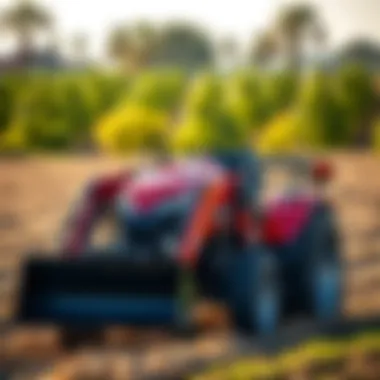
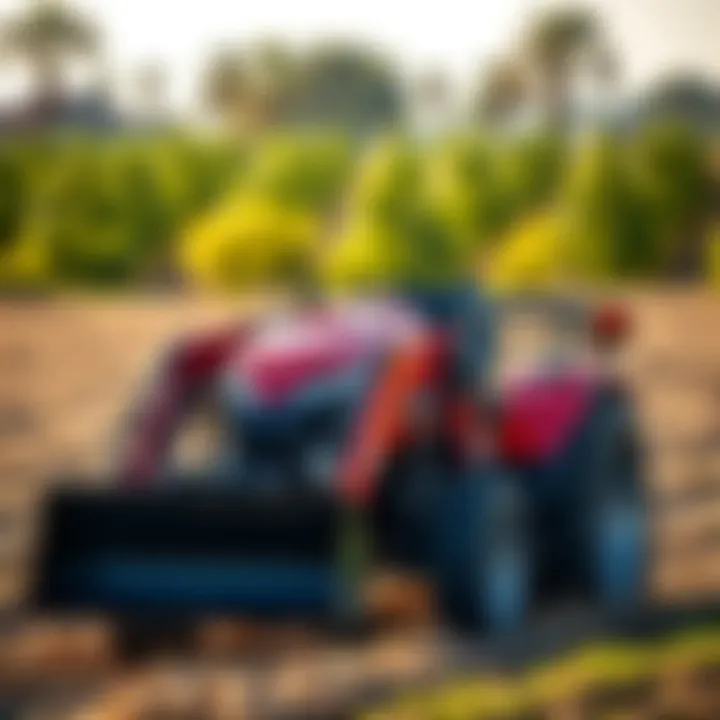
Intro
In the realm of modern agriculture, small tractors equipped with front buckets stand as a testament to innovation in farming practices. These compact machines, tailored for versatility, fit right into smaller plots while providing immense power and efficiency. With their ability to maneuver through tight spaces and undertake various tasks, small tractors have become essential tools for farmers and horticulturists aiming to enhance productivity.
The inclusion of a front bucket transforms a basic tractor into a multifaceted workhorse. Whether it’s moving soil, lifting bales, or transporting materials across the farm, these machines deliver superb functionality. Understanding how these tractors excel in diverse applications opens a whole new world of possibilities for small scale farmers and gardening enthusiasts alike.
In the following sections, we will explore key insights about small tractors with front buckets, emphasize their importance in agricultural settings, and delve into sustainable practices that can be employed. By equipping ourselves with in-depth knowledge, we can make informed decisions regarding the selection and use of these valuable machines.
Prologue to Small Tractors
In the world of agriculture, small tractors occupy a pivotal role that often goes unnoticed. Their ability to perform a variety of tasks efficiently makes them an indispensable tool for farmers and gardening enthusiasts alike. In this guide, we explore the nuances of small tractors, particularly those equipped with front buckets, highlighting their utility and importance in modern agricultural practices.
Definition and Importance
Small tractors are compact machines designed to assist in various agricultural tasks such as plowing, tilling, and hauling. Typically lighter and more maneuverable than their larger counterparts, these tractors can navigate tight spaces in gardens or small fields where bigger tractors would struggle. Moreover, their versatility allows for easy attachment of different implements, most notably the front bucket.
The front bucket is not merely an add-on; it is an essential attachment that enhances the functionality of small tractors. Farmers can use it for digging, lifting, and transporting materials like soil, mulch, or gravel. This functionality translates into significant time and labor savings, allowing farmers to focus on other critical tasks.
Using small tractors equipped with front buckets means increased efficiency at work. The ability to complete demanding tasks quickly and accurately can turn a labor-intensive process into a more manageable one. Therefore, understanding these small tractors is crucial for any farmer looking to improve output without compromising on quality.
Historical Development of Tractors
Tractors have come a long way since their inception in the late 19th century. The earliest models were steam-powered and cumbersome, limiting their usage mostly to larger farms. However, with the transition to gasoline and diesel engines in the 20th century, tractors became more accessible and practical.
Small tractors, in particular, emerged as innovators of agricultural technology. During the 1950s, as farming methods evolved, so did the need for more efficient equipment. Tractors were scaled down in size, but not in power. This smaller, more efficient design catered to diverse tasks on smaller farms, ensuring that farmers could maintain productivity without the overhead costs associated with larger tractors.
Today, the evolution of small tractors continues, incorporating modern technologies such as GPS and automated systems to optimize farm management. The front bucket attachment, now widely used, symbolizes this blend of tradition and innovation. It showcases how farmers adapt to changing needs while emphasizing usability and efficiency.
"Understanding the history of tractors gives insight into how essential they are to the agricultural landscape today."
In summary, small tractors equipped with front buckets represent a synthesis of history, practicality, and technological advancement in agriculture. Their role cannot be overstated; by streamlining tasks, they empower farmers to achieve more in less time, making them a worthy investment in any agricultural operation.
Features of Small Tractors
Small tractors bring a unique set of features to the table, making them invaluable in various agricultural settings. Knowing what these tractors offer can change the game for farmers, allowing not just for better productivity but also enhanced efficiency in handling daily tasks. The specific attributes of these tractors can transform what once was considered laborious into a streamlined process. For those in the agriculture industry, understanding these features becomes paramount.
Size and Maneuverability
One standout characteristic of small tractors is their size. When you compare them to their larger counterparts, small tractors have a more compact frame. This means they can easily navigate through narrow spaces or tight corners—like the winding pathways of an orchard or the rows of densely planted vegetable fields. This nimbleness enables farmers to tackle a variety of tasks that might be too cumbersome for standard tractors. The ability to fit into confined spaces without damaging crops is a significant advantage.
Moreover, the weight distribution and ground clearance of small tractors allow them to work effectively on uneven terrains. An efficient maneuvering also reduces crop damage, which is often a concern when using heavier machinery.
"The right size tractor can make the difference between a productive day and a logistical headache in the field."
Engine Specifications
Engine specifications play a critical role in the performance of small tractors. Typically, small tractors are equipped with engines ranging from 15 to 50 horsepower. This power is more than adequate for typical farming tasks such as plowing, tilling, and hauling. However, the real kicker lies in the efficiency of these engines—often, they are designed to be fuel-efficient while still delivering the horsepower needed to get the job done. This does not just save costs; it also lessens the environmental impact, a growing concern among eco-conscious farmers.
In more technical terms, many new small tractors feature diesel engines, which offer greater longevity and torque compared to gasoline engines. Additionally, some smaller models come with liquid-cooled designs that help regulate temperature and enhance overall performance, especially during long operational hours.
Hydraulic Systems
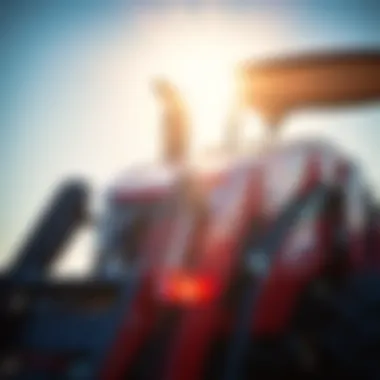
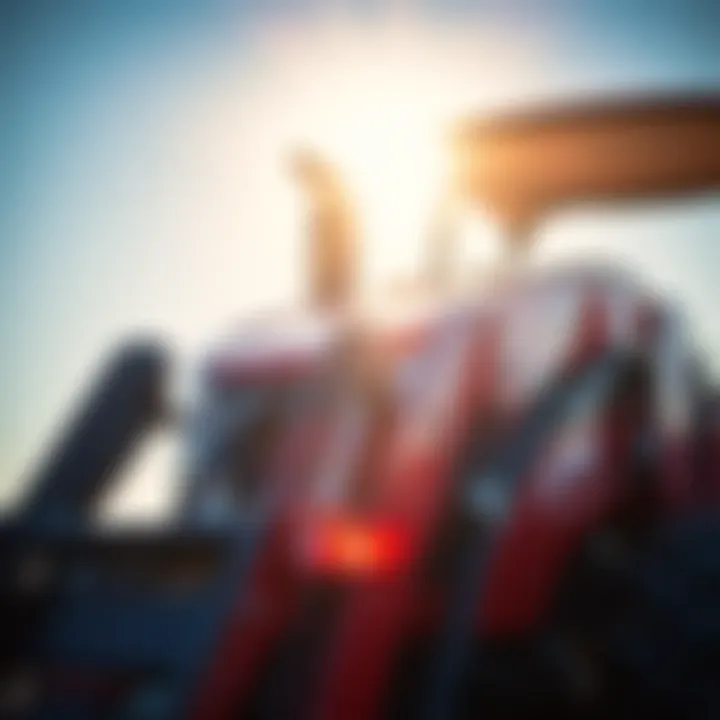
One cannot discuss the features of small tractors without acknowledging their hydraulic systems. These systems are essential in powering attachments like front buckets, which drastically expand the utility of the tractor. A well-designed hydraulic system provides precise control when lifting and moving heavy loads, whether it’s a bucket full of soil or a pile of gravel.
The hydraulic power on small tractors is generally measured in GPM (gallons per minute), providing farmers the capability to operate multiple hydraulic attachments simultaneously. Quick connect hydraulics are another feature found on many modern small tractors, enabling swift changes between attachments without fuss, allowing for more time spent working and less time fiddling around.
In summary, the features of small tractors significantly improve efficiency for various tasks in agriculture. Understanding these specifics—from size and engine capabilities to hydraulic systems—can empower farmers to make informed purchasing decisions that align with their operational needs.
The Front Bucket: An Essential Attachment
When it comes to small tractors, the front bucket stands out as perhaps the most vital attachment a farmer or land enthusiast can have. This tool not only enhances the utility of the tractor but also significantly boosts productivity in various tasks, allowing users to make the most out of their investments. A front bucket transforms a small tractor into a multipurpose workhorse, making it capable of handling a myriad of applications — from simple material handling to more complex field preparations. Understanding its functionality and varieties is crucial for anyone considering adding this attachment to their machine.
Functionality and Versatility
The front bucket is crafted for a variety of tasks that range from lifting, moving, to dumping materials. Its versatility is what makes it a staple for small tractors. Whether you are shifting soil, scraping debris, or loading materials onto a truck, the front bucket can do it all with relative ease.
A prime feature of front buckets is their capacity to pivot smoothly, which allows operators to maneuver their tractor in tight spaces. This is particularly beneficial in agricultural settings, where space can be at a premium. Moreover, the bucket can be detached and replaced with other implements, which further adds layers to its utility.
The ability to switch attachments enables a small tractor to perform tasks that would otherwise require multiple machines, hence saving both time and labor.
Though useful for moving materials, the front bucket's true strength lies in its adaptability — no matter the job, whether it’s construction or landscaping, having a front bucket means you can face challenges head-on.
Types of Front Buckets
There are several types of front buckets, each tailored for different tasks and applications. Understanding these various styles can help users choose the most suitable one for their needs.
Standard Buckets
Standard buckets are the bread and butter of front bucket attachments; they are typically used for tasks like scooping soil or gravel. One of their defining characteristics is their broad, flat design, which allows for efficient loading and unloading of materials. These buckets are favored for their easy compatibility with most small tractors, making them a popular choice among farmers who require basic functionality without frills.
The unique feature of standard buckets is their capacity to handle a variety of material weights and types — from loose dirt to heavier aggregates. However, they may not be suitable for extremely dense or abrasive materials, which could lead to wear and tear over time.
Skid Steer Buckets
Skid steer buckets are designed with a wider opening and are typically employed in more demanding environments, such as construction sites or rugged agricultural settings. The standout characteristic of skid steer buckets is their robust build, which allows them to lift heavier loads. They are especially advantageous for those who need to penetrate the ground or move heavier materials, thereby contributing effectively to tasks such as grading and leveling.
However, their increased width might limit some users if they're working in confined spaces. Still, their durability and weight-bearing capabilities often make them a must-have for serious operations.
Construction Buckets
Designed with heavy-duty tasks in mind, construction buckets are blunter and more resilient than standard options. They are often employed in earth-moving projects and have a reinforced structure that allows them to withstand the rigors of rugged applications. The key characteristic of construction buckets lies in their ability to handle tough jobs without compromising performance.
One unique feature includes the curved edges that aid in scooping earth more effectively. While these buckets can tackle substantial loads, they might add extra weight to your small tractor, which can affect maneuverability. However, the advantages in performance often justify any limitations, especially in scenarios requiring heavy lifting.
Applications in Agriculture
When it comes to utilizing small tractors with front buckets in agriculture, the benefits are as clear as day. These machines are more than just tools; they're vital assets that streamline diverse farming tasks. From turning over soil in fields to moving heavy loads efficiently, the applications of small tractors cover a wide array. Understanding how they can be applied in every corner of agricultural work aids farmers in making informed decisions while maximizing productivity.
Field Preparation
Proper field preparation sets the stage for successful crop production. With the aid of small tractors equipped with front buckets, farmers can easily manage several tasks that form the backbone of getting land ready for planting. These tasks include:
- Clearing Debris: Before the planting season, it’s essential to remove stones, branches, and other debris that can obstruct the growth of crops. The front bucket allows for effective lifting and moving of these unwanted materials.
- Tilling Soil: While primary tillage often requires larger equipment, front buckets can assist in shallow tilling or turning open soil patches. This can be particularly useful in smaller plots.
- Creating Seed Beds: Farmers can also use front buckets to gather soil and form seed beds. This method can ensure that soil is properly aerated, also improving water drainage conditions that are crucial for seed germination.
"Field preparation is not just about making the soil ready; it's the first step towards a successful harvest."
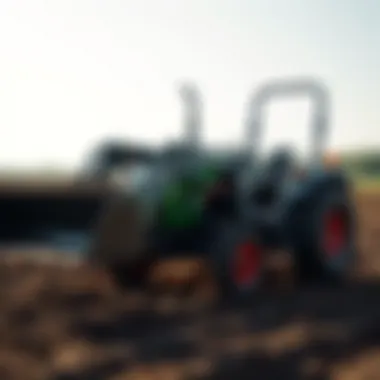
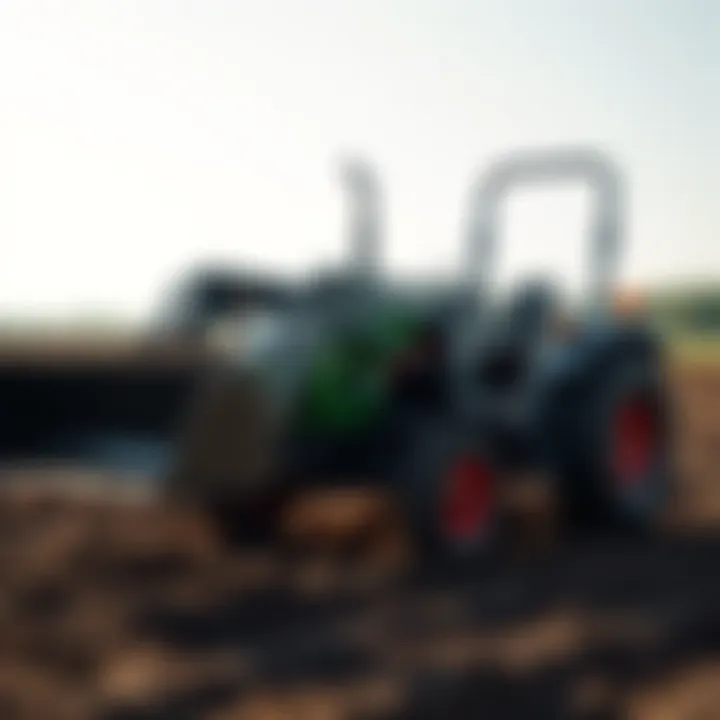
Material Handling
Material handling is at the heart of efficient farm operations, and small tractors with front buckets play an indispensable role here. These machines aid in lifting, transporting, and placing various agricultural products, improving workflow significantly. Key points to consider include:
- Transporting Feed and Fertilizers: Moving bulk feed or fertilizers is often time-consuming. With a front bucket, farmers can load and transport materials swiftly, reducing time spent on these repetitive tasks.
- Loading and Unloading: Whether it’s bales of hay, equipment, or harvested crops, front buckets make loading and unloading streamlined operations. The ease of using a small tractor minimizes physical strain on farmers, enabling them to work longer with less fatigue.
- Post-Harvest Handling: Once crops are harvested, they need to be moved from fields to storage. Front buckets are perfect for this job, allowing for easy loading onto trucks or into storage facilities.
Landscaping and Gardening Tasks
Small tractors equipped with front buckets aren’t just limited to farming practices; they also thrive in landscaping and gardening. The versatility of these tractors can transform a landscape or garden project from labor-intensive to efficient. Here’s where they shine:
- Soil Movement: Be it for large-scale landscaping projects or small garden setups, front buckets are excellent for moving soil. Whether you’re leveling a garden bed or creating a pathway, having this capability is a game-changer.
- Mulch and Rock Distribution: Distributing mulch or decorative gravel can easily become a back-breaking task. With a tractor and front bucket, transferring and placing these materials becomes straightforward, allowing for an even flow without excessive manual labor.
- Maintenance Tasks: Regular maintenance often involves clearing out old plants, working on drainage systems, or reshaping land. A front bucket is ideal for digging up roots, moving excess soil, or even removing debris left behind after a project.
In essence, the applications of small tractors equipped with front buckets aren’t just beneficial—they're foundational aspects of modern agricultural practices. Their versatility enhances efficiency, making agricultural work vastly more manageable and less grueling.
Selecting the Right Small Tractor
Choosing the right small tractor is like picking the right tool from your workbench—each has its fit and function. This vital decision can have ripple effects on your efficiency, productivity, and overall satisfaction. With so many options on the market, it’s crucial to consider your specific needs, budget implications, and maintenance aspects. Making an informed choice not only saves you time but also money in the long run. Let’s break this down into manageable parts.
Evaluating Your Needs
The first step in selecting a small tractor involves evaluating your needs. Think about the tasks you intend to tackle, whether it's mowing, tilling, loading materials, or even snow removal. You wouldn’t want to invest in a model that’s too robust for your modest gardening needs, nor would you want a compact option that struggles under heavy loads at a farm.
- Identify Task Requirements: Determine if you need a tractor mainly for light duties or for more intense operations. Different tasks will dictate the horsepower and size necessary.
- Land Size: Smaller plots may not need the power or size of larger machines, thus offering savings on fuel and maintenance.
- Attachments: Are you planning to use various attachments? Ensure the tractor you choose can support them effectively. Things like front buckets, tillers, and mowers require specific compatibility.
This step is about aligning your actual requirements with the machine capabilities, which can solidify your purchase decision.
Assessing Budget Constraints
Understanding your budget is a necessity that can simplify your selection process. While it might be easy to get dazzled by features, it’s wise to focus on affordability without compromising quality. Here are a few pointers:
- Initial Cost vs. Long-term Investment: Sometimes, spending a bit more on a reliable model pays dividends down the road, especially when it comes to repairs and performance longevity.
- Operational Costs: Factor in ongoing expenses such as fuel consumption, insurance, and maintenance. Economical models may offer lower costs over time.
- Financing Options: Many dealers provide financing plans that can spread out the costs, though keeping an eye on interest rates and terms is essential.
Budget shopping isn't just about finding the cheapest option; it’s about finding the right balance between upfront costs and overall value.
Considerations for Maintenance
Regular maintenance is the heartbeat of any small tractor's longevity. Before finalizing your choice, consider how easy it is to maintain the unit you're eyeing. Here’s what to keep in mind:
- Manufacturer Support: Opt for brands known for their availability of parts and support. A reliable source for replacement parts can make repairs straightforward rather than a headache.
- Ease of Service: Some tractors require more complicated service routines than others. Look for ones with easy-to-access engine compartments and a straightforward design.
- Free Maintenance Tips: Invest your time in tutorials or forums where users share maintenance advice. Simple knowledge on oil changes or filter replacements can save you a bundle.
Regular upkeep keeps your tractor running smoothly and efficiently, ensuring that you reap the most benefit from your investment.
"A well-maintained tractor can outlast its competition, often saving funds on repairs and replacements."
Safety and Operational Guidelines
Understanding safety and operational guidelines is vital for anyone using small tractors with front buckets. These machines, though incredibly efficient, can pose risks if not handled correctly. The importance of these guidelines cannot be overstated, as they not only ensure the operator's safety but also protect others in the vicinity and maintain the longevity of the equipment. Prioritizing safety translates directly to improved productivity, as fewer accidents lead to more time spent on essential tasks.
Basic Safety Equipment
To begin with, having the right safety equipment is a non-negotiable aspect of operating small tractors. Some essential gear includes:


- Protective Helmets: Wearing a helmet can prevent serious head injuries, particularly when working on uneven terrain where the chance of falling debris exists.
- Safety Glasses: These are crucial for protecting your eyes from dust, debris, and any other flying particles when operating a tractor or when the front bucket is in action.
- Ear Protection: Tractors tend to be noisy, and prolonged exposure to loud machinery can lead to hearing loss. Noise-canceling earmuffs or earplugs should be part of your standard gear.
- High Visibility Vests: These are necessary for ensuring that operators and bystanders are easily seen, especially in busy agricultural settings.
- Steel-Toed Boots: These provide necessary foot protection in case of heavy objects being moved or accidentally dropped.
Each piece of safety equipment plays a role in preventing accidents and minimizing risks associated with operating machinery. Regardless of how experienced an operator may be, it’s crucial to wear safety gear consistently.
"Prior preparation prevents poor performance."
Common Operational Hazards
Alongside safety equipment, recognizing common operational hazards while working with small tractors and front buckets is fundamental. Some typical hazards include:
- Overturning Risks: Small tractors may be susceptible to overturns, especially when on slopes or uneven ground. Operators should know how to handle inclines, ensuring proper load distribution in the bucket, which can help maintain stability.
- Moving Parts: The hydraulic systems that operate the front buckets can pose serious risks if operators become complacent. Always ensure that limbs and loose clothing are kept clear when operating machinery – a finger caught in moving parts could mean serious injury.
- Visibility Issues: Operating a tractor with a front bucket can obstruct the operator's view. It's crucial to be aware of surroundings and verify there are no obstacles or people in the immediate area before moving.
- Uneven Terrain: It’s easy to underestimate the challenges presented by rocky or muddy fields. Operators should always be vigilant for changes in terrain that may affect traction or stability.
- Mechanical Failures: Regular maintenance is instrumental. It’s easy to overlook minor issues, but equipment failures can lead to hazardous situations, like losing control of the tractor while in motion.
By being conscious of these hazards and taking actionable steps to mitigate risks, operators can create a safer working environment.
For more comprehensive information on tractor safety and maintenance, you can visit OSHA.gov or CDC.gov.
Overall, safety and operational guidelines not only protect lives but enhance the functionality and efficiency of small tractors in agricultural settings.
Trends in Small Tractor Technology
Embracing the cutting-edge advancements in technology is critical for small tractors, especially as we navigate the complexities of modern agriculture. The adoption of innovative features not only enhances the efficacy of these machines but also aligns farming practices with sustainable development goals. Let’s dig into how some of these trends are shaping the future of small tractors equipped with front buckets.
Integration of Digital Tools
With technology evolving at breakneck speed, digital tools are becoming essential for optimizing the performance of small tractors. Farmers and contractors are harnessing GPS technology, telematics, and precision farming tools to gain better insights into their operations.
- GPS Technology: Helps in tracking machine performance and ensuring tasks are performed precisely. For instance, auto-steering systems allow for consistent row spacing in fields, significantly reducing overlap waste and saving fuel.
- Telematics: When equipped with telematics systems, a tractor can communicate its operational data. This helps farmers to monitor engine health, analyze fuel usage, and schedule maintenance proactively. Having these insights can lead to a more efficient management of resources by catching issues before they escalate.
- Mobile Applications: Apps can synchronize with tractors, providing real-time data on weather, soil conditions, and crop health. This can help farmers make informed decisions on when to plow or fertilize.
The overall influence of these tools cannot be overlooked. They offer farmers a view into operational performance that was previously unattainable, enabling better decision-making and increased efficiency in their tasks.
Sustainable Practices and Innovations
The agricultural landscape is facing mounting pressure to adopt sustainable practices. Enter small tractors, equipped with front buckets that are designed to be not only productive but also eco-friendly. The trend toward sustainable innovations in tractor technology is guiding the industry to greener pastures.
- Fuel Efficiency: Modern small tractors often feature advanced engine designs and hybrid models that minimize fuel consumption while maximizing output. Reducing fuel use not only cuts costs but also lowers greenhouse gas emissions, which is a win-win for the environment.
- Biodegradable Lubricants: Many manufacturers are now emphasizing the use of biodegradable oils and greases. This is a step forward, as reducing chemical runoff contributes to healthier ecosystems.
- Reducing Soil Compaction: Innovations in tire technology, such as low-pressure or wider tires, help distribute the weight of the tractor more effectively across the soil. This minimizes compaction, promoting better root development and crop health.
Implementing these sustainable practices is vital for future farming operations. Farmers adopting such technologies are not just working to improve their productivity today; they’re also investing in the longevity of the land for generations to come.
Embracing technology and sustainability isn’t just a fad. It’s the future of farming.
With challenges like climate change and the demand for more food to feed a growing population, trends in small tractor technology highlight the balance between productivity and environmental stewardship. Keeping ahead of these trends will ensure that small farmers remain resilient, adaptable, and environmentally conscious as they shape the agricultural tapestry of the future.
Epilogue
In finishing our journey through the world of small tractors with front buckets, it's clear that this is more than just a niche piece of equipment; they are essential tools for modern agricultural practices. These tractors not only enhance productivity but also provide versatility that can’t be overlooked. Their compact size allows farmers to maneuver easily in tight spaces, while the front bucket attachment opens a myriad of operational possibilities.
These machines bridge the gap between utility and ease, making them a vital asset for anyone in agriculture.
Summarizing Key Insights
Throughout this article, several key insights have emerged about small tractors with front buckets:
- Operational Efficiency: The synergy between a small tractor and a front bucket significantly streamlines tasks that would otherwise require labor-intensive efforts. From soil preparation to material transport, these tractors cut down on time and enhance output.
- Adaptability in Various Settings: These tractors are not just limited to large fields; they thrive in diverse environments, whether it’s farms, gardens, or even landscaping businesses. Their design makes it simple to switch tasks, thus catering to the dynamic needs of users.
- Safety Features are Crucial: Understanding the operational hazards and equipping oneself with the proper safety gear can prevent accidents. As discussed, it’s vital to always prioritize safety when operating machinery.
- Technological Integration: The trends in small tractor technology, like the incorporation of digital tools, signal a shift toward more automated processes in agriculture, which can enhance precision farming and resource management.
Future of Small Tractors in Agriculture
Looking ahead, the small tractor's role in agriculture appears only to be expanding. Farmers are continually seeking efficient ways to optimize their operations, and small tractors with front buckets are right in the middle of this evolution.
- Sustainability Focus: As the agricultural sector increasingly turns to sustainable practices, small tractors offer a path towards eco-friendly farming. Their efficiency helps minimize fuel use and reduce carbon footprints, aligning with global environmental goals.
- Smart Farming Integration: The advent of IoT (Internet of Things) in agriculture means tractors could soon be part of a smarter ecosystem. Think about sensors that offer real-time data on crop health or yield. Small tractors could be equipped to participate in this new age, where decisions are made based on data rather than hunches.
- Affordability and Accessibility: As technology advances and production methods improve, we might see a further reduction in costs, making these tractors more accessible to a broader range of users, including smaller farms and individual gardeners.







